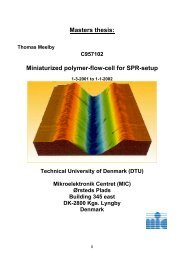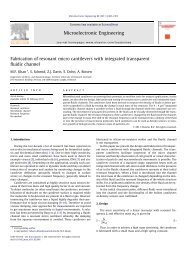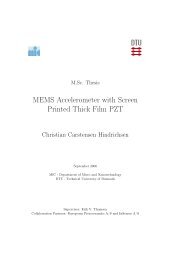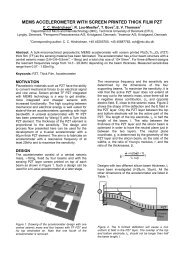Prototyping of microfluidic systems with integrated ... - DTU Nanotech
Prototyping of microfluidic systems with integrated ... - DTU Nanotech
Prototyping of microfluidic systems with integrated ... - DTU Nanotech
Create successful ePaper yourself
Turn your PDF publications into a flip-book with our unique Google optimized e-Paper software.
2.3 Waveguide optics 13<br />
For waveguides <strong>with</strong> a cross section larger than 10 µm the propagation<br />
can be treated using ray optics. Also, a larger number <strong>of</strong> modes is allowed<br />
simultaneously in the fibre. The waveguides treated in this thesis have<br />
cross sectional dimensions in the 100–200 µm range, and are thereby<br />
clearly multi-mode fibres.<br />
2.3.1 Snell’s law<br />
When a beam <strong>of</strong> light travels from one medium to another <strong>with</strong> different<br />
refractive index, the light is refracted according to Snell’s law:<br />
n1 sin(θ1) = n2 sin(θ2) (2.5)<br />
where n1 and n2 are the refractive indices <strong>of</strong> the first and second material,<br />
respectively, and θ1 is the incoming, and θ2 the outgoing angle <strong>with</strong><br />
respect to the normal <strong>of</strong> the interface between the two materials.<br />
When moving from a dense to a less dense medium, meaning that<br />
n1 > n2, it is readily seen that no solution exists to the equation when<br />
θ1 exceeds a critical angle θc defined by<br />
n2 n1 θ 2 θ1<br />
θc = arcsin n2<br />
n1<br />
(2.6)<br />
Figure 2.2: The principle <strong>of</strong> total internal<br />
reflection. A light beam incident on<br />
an interface between a medium <strong>of</strong> refractive<br />
index n1 and a medium <strong>of</strong> refractive<br />
index n2 < n1, and entering at an angle<br />
θ1 smaller than a critical angle θc is<br />
partly refracted and partly reflected. If<br />
the incident angle exceeds the critical angle,<br />
no light is refracted. Instead, total<br />
internal reflection occurs.<br />
As illustrated in Fig. 2.2 a beam incident at an angle θ1 < θc the<br />
beam is partly reflected, and partly refracted at the interface. The larger<br />
the incident angle, the larger the part <strong>of</strong> the light which is reflected. For<br />
a beam entering at an angle θ2 > θc, no light is refracted. Instead all<br />
light undergoes total internal reflection.










